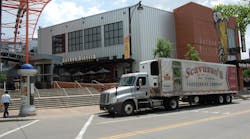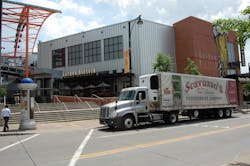Joseph Dack, transportation logistics project manager with global engineering firm HDR Inc., chimed in with his experience dealing with the challenges posed by urban logistics – especially in terms how to better allocate ever-more-precious city road space relieve traffic congestion.
“As you point out, there is a trend for increased urbanization and this is a global phenomenon,” he told me. “Of course, there are many issues within cities, but one fundamental aspect is how road space is allocated between the different users of auto, bus, cyclist, freight, etc.”
In most urban planning situations, Dack said freight activity is often forgotten – even ignored – yet in some major cities, such as New York City (NYC) and London, a new approach is taking shape: the use of dedicated “freight teams” to ensure the needs of cargo movement gets incorporated into the larger urban transportation planning process.“Most cities are being confronted with the fact that there will not be any new roads built, so other approaches are being proposed,” he explained.
“Transit options are better in terms of road space utilization – 40 people in one bus, versus 40 people in 40 cars – which helps free up road capacity for modes such as freight where there is no other option than a truck on the road,” Dack added.
One way New York and London are trying to reduce traffic flow and provide for freight needs simultaneously is by promoting the wider use of “off hour” delivery schedules.
“While it is recognized that there are immediate cost issues – such as driver wage premiums – there are benefits that may outweigh those costs,” Dack noted. “A program in NYC found that off-hour deliveries are more productive as an operator can get more deliveries in, better fuel efficiency, less parking tickets, double shift vehicles and the goods receiver gets more reliable, on time deliveries.”
Another example concerns the London Route 38 Bus Priority plan – you can read more about that here – which included a different approach to handling curbside freight unloading activity.
“The project sought to increase bus frequency and improve journey times along Shaftesbury Avenue, a congested road in central London,” Dack explained. “But one of the issues impeding traffic flow was trucks unloading. So a solution was developed that allowed trucks to stop on the sidewalk/pavement – material designed and constructed in such a way to allow this – at certain times, thereby avoiding both peak bus and pedestrian movements.”The learning point here, he said. Is that by understanding truck loading and unloading activity, London developed an overall traffic scheme that works for both truck operators and the buses. “Not all road design schemes take this issue into account,” Dack stressed.
Of course, he readily admits that while such efforts will work for some freight operators, they won’t work for all of them and not others.
Yet Dack said a point worth noting about both New York’s “off-hours” delivery and London’s curbside truck parking efforts is that both demonstrate how cities are focusing on ways to work more collaboratively with the freight industry.
“Cities and [freight] operators may not always see eye to eye, but the common objective of trying to achieve a better, safer transport network: one where freight operators can efficiently transport and deliver the goods the city population demands,” he emphasized. “Those are benefits recognized by both parties and certainly worth striving for.”






